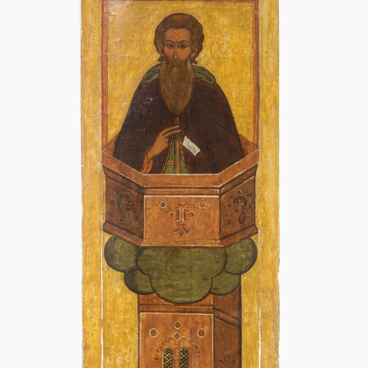Saint George the Great Martyr is the patron saint of the Russian land, a brave and courageous warrior. Since ancient times, he enjoyed great love and respect. He was venerated by grand princes and ordinary warriors, peasants and artisans. The image of George as a rider with a spear, slaying a dragon, adorned the seal and coat of arms of the Muscovite Rus, its battle banners from the 15th century.
Churches were erected in honor of the saint, and icon painters received commissions to create large hagiographic icons. However, the most frequent subject was “St. George and the Miracle of the Dragon” — a generally accepted symbol of the struggle between good and unshakable faith against evil.
The story of St. George tells about his unshakable faith in God, about how the Lord came to his aid during the terrible tortures that Diocletian, the persecutor of Christians, subjected the saint to. It also describes a number of miracles performed by the saint, including his victory over the terrible dragon, who demanded human sacrifices, and saving Princess Yelisava.
This icon depicts an abbreviated version of the story. The triumphant George, wearing blue and gold armor, is depicted on a rearing black horse with a scarlet cloak fluttering behind his shoulders. He stands up in his stirrups and pierces the mouth of a writhing winged dragon, crawling out of the cave, with his spear. The fact that he did a charitable and righteous deed is reminded by the blessing of God’s right hand, depicted in the upper right corner. Also, the scarlet cross at the end of the spear means that George defeated the dragon not by his own military valor, but by the righteous Christian word, “the sword of the spirit.”
The icon is special in that it also features other saints. The traditional combination of the images of St. George and St. Nicholas the Wonderworker additionally includes the image of the Mother of God.
In addition, the holy martyrs and healers Cosmas and Damian, Saint Paraskeva Friday and Bishop Blaise of Sebaste, who is said to have healed animals, are also depicted in the icon.
Overall, the image is a domestic “iconostasis”, made in accordance with the needs of peasant life. An increase in the number of the depicted saints led to some changes in the composition of the drawing: the saint’s hand, which was traditionally raised high, was depicted bent, and the segment of the sky with the blessing hand — a significant semantic element of the image — was moved from the right corner closer to the center.
This image was transferred to the museum in 1922 from the National Museum Collection, along with icons of the 15th–17th centuries, to create the Department of Old Russian Art. All the monuments came from private Moscow collections.
Churches were erected in honor of the saint, and icon painters received commissions to create large hagiographic icons. However, the most frequent subject was “St. George and the Miracle of the Dragon” — a generally accepted symbol of the struggle between good and unshakable faith against evil.
The story of St. George tells about his unshakable faith in God, about how the Lord came to his aid during the terrible tortures that Diocletian, the persecutor of Christians, subjected the saint to. It also describes a number of miracles performed by the saint, including his victory over the terrible dragon, who demanded human sacrifices, and saving Princess Yelisava.
This icon depicts an abbreviated version of the story. The triumphant George, wearing blue and gold armor, is depicted on a rearing black horse with a scarlet cloak fluttering behind his shoulders. He stands up in his stirrups and pierces the mouth of a writhing winged dragon, crawling out of the cave, with his spear. The fact that he did a charitable and righteous deed is reminded by the blessing of God’s right hand, depicted in the upper right corner. Also, the scarlet cross at the end of the spear means that George defeated the dragon not by his own military valor, but by the righteous Christian word, “the sword of the spirit.”
The icon is special in that it also features other saints. The traditional combination of the images of St. George and St. Nicholas the Wonderworker additionally includes the image of the Mother of God.
In addition, the holy martyrs and healers Cosmas and Damian, Saint Paraskeva Friday and Bishop Blaise of Sebaste, who is said to have healed animals, are also depicted in the icon.
Overall, the image is a domestic “iconostasis”, made in accordance with the needs of peasant life. An increase in the number of the depicted saints led to some changes in the composition of the drawing: the saint’s hand, which was traditionally raised high, was depicted bent, and the segment of the sky with the blessing hand — a significant semantic element of the image — was moved from the right corner closer to the center.
This image was transferred to the museum in 1922 from the National Museum Collection, along with icons of the 15th–17th centuries, to create the Department of Old Russian Art. All the monuments came from private Moscow collections.



